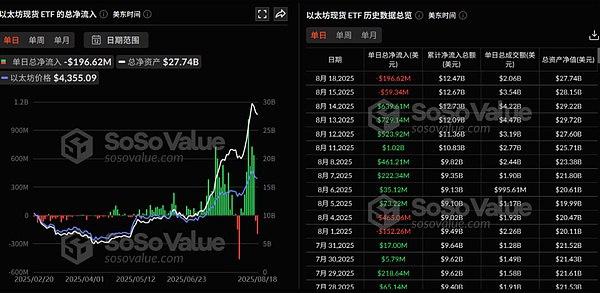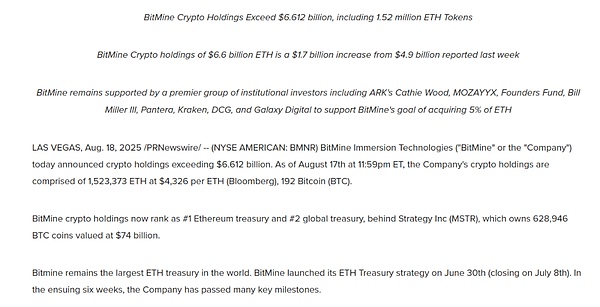Ethereum is at an unprecedented juncture of "multiple narrative resonance." On-chain, ETH staking continues to climb, gradually establishing a risk-free interest rate anchor. In traditional finance, spot ETFs have been operating for over a year, with trading volume and net inflows rapidly increasing, signaling a continued surge in compliant capital. Corporately, a growing number of US-listed companies are strategically adding ETH to their treasury reserves. Staking, ETFs, and corporate treasuries—these three seemingly independent threads are now intertwined, driving ETH from a simple crypto token into a comprehensive financial asset with income-generating properties, compliant channels, and corporate reserve value. If Bitcoin's story is about "digital gold," then Ethereum's narrative is quietly shifting to "global ledger," reaching a critical "resonance moment" in 2025. Staking steadily climbs, and the ETH "base rate" emerges. Since Shanghai upgraded and opened the staking withdrawal function in April 2023, Ethereum has completely resolved the hidden dangers of a blockage-like exit, unleashing the growth potential of the staking ecosystem. Since then, the LSD-based derivatives market has expanded rapidly, driving the ETH staking rate higher. As of the time of writing, ETH stake has exceeded 33.8 million, equivalent to approximately $140 billion at current prices, representing over 25% of the total supply. This represents a significant increase from the staking rate of approximately 10% a few years ago. This not only strengthens network security but also increases ETH's scarcity from both a supply and demand perspective. More importantly, ETH staking is gradually becoming the "interest rate anchor" for on-chain finance. Over the past year, an annualized staking return of 3%-5% has been widely accepted by the market, even being considered an "on-chain version of Treasury yields" in some institutional research reports, forming an implicit comparison with the US Treasury yield curve. This attribute has made ETH more than just a trading asset, but rather possessed the underlying logic of a quasi-fixed-income product. Of course, a noteworthy counter-trend has also emerged recently: since July 16th, ETH unstaking requests have surged, with validator exit requests soaring from less than 2,000 to 475,000 on July 22nd, and wait times extending from less than an hour to over eight days. According to data from The Block, there are currently about 670,000 ETH (about 3.1 billion US dollars) in the exit queue, far exceeding the demand for new staking. The processing time is expected to be close to 12 days. Among them, the unwinding of the leveraged staking cycle under the background of rising prices, the risk of LST decoupling and arbitrage opportunities are the main reasons for driving the large-scale unstaking of ETH. Therefore, Lido, EthFi and Coinbase are the main sources of exits.

Source: The Block
However, although the unstaking wave has brought fluctuations in the short term,
from a long-term perspective, ETH staking has gradually become the "risk-free interest rate anchor" on the chain,and has become one of the underlying financial logics of ETH. It's worth noting that in 2024, US Treasury yields remained in the 4%–5% range for a long time, making ETH staking rates seemingly unattractive. However, with the Federal Reserve's interest rate cuts beginning in 2025, ETH's staking yield of 3%–5% has become competitive again, even considered "excess returns" in some risk models. This suggests a deeper, implicit connection is developing between ETH's on-chain interest rate and the global liquidity environment. This is particularly true with restaking protocols like EigenLayer, which have already attracted over tens of billions of dollars in ETH, fostering a chain reaction of "staking rate → restaking premium → protocol security." In other words, ETH is not just an asset itself; it is also gradually becoming the underlying collateral of the Web3 financial system. ETF becomes the main channel for traditional funds
In May 2024, the U.S. SEC approved the 19b-4 applications of 8 Ethereum spot ETFs, and they were officially listed and traded on July 23, marking the official opening of the compliance channel between ETH and Wall Street. To date, the Ethereum spot ETF has been in operation for more than a year. Objectively speaking, ETFs, as a "compliant entry point," provide traditional institutions with a direct channel for allocating ETH, while also reducing compliance friction at the financial and audit levels. According to SoSoValue data, as of now, the total net asset value of US Ethereum spot ETFs has exceeded $27 billion, representing approximately 5.34% of Ethereum's market capitalization. Since its listing, cumulative net inflows have reached $12.4 billion. However, in the early stages of development, the market tends to overestimate the short-term effects of new things and underestimate their long-term impact. The development of the ETH spot ETF is a microcosm of this principle, as the true explosion of ETFs was not immediately apparent. Before May of this year, the average daily trading volume of the ETH ETF remained low, and market interest was limited.

Source: SoSoValue
The turning point occurred on August 11, 2025. On that day, the single-day net inflow of Ethereum ETF exceeded US$1 billion for the first time. Among them, BlackRock's ETHA attracted US$640 million and Fidelity's FETH attracted US$277 million. The capital siphoning effect of the two giants was highlighted, and the institutionalization shift of Ethereum ETF has become apparent. The significance of ETFs lies in that they serve not only as a "channel" for funds but also as a "legal status" in compliance audits and financial statements, greatly reducing the resistance for institutions to hold ETH. Another far-reaching significance is that they open up arbitrage and allocation paths for cross-border financial institutions. More importantly, the concentration of ETF holdings has begun to emerge. BlackRock and Fidelity's two major ETFs account for two-thirds of the US ETH ETF market. This trend of head-to-head competition not only brings about a capital siphoning effect, but may also mean that the "institutional pricing" characteristics of ETH will become increasingly prominent in the future.
ETH is accelerating into U.S. stock balance sheets
If MicroStrategy is a milestone case for listed companies to include crypto assets in their balance sheets, then starting in 2025, ETH is also ushering in a similar turning point.
Recently, more and more U.S.-listed companies have chosen to include ETH in their treasury, and not just symbolic holdings, but large-scale, strategic allocations.
Take BitMine as an example. According to official disclosure,
its crypto asset holdings have exceeded US$6.612 billion, an increase of approximately US$1.7 billion compared to US$4.9 billion the previous week.Of these, BitMine holds 1.523 million ETH (calculated at the current price of US$4,326 per ether) and 192 BTC. 
Source: BitMine
At the same time, Nasdaq-listed Cosmos Health also announced that it had reached a securities purchase agreement with a US institutional investor for up to US$300 million to launch its ETH treasury strategy and provide custody and staking infrastructure through BitGo Trust.
This trend of active inclusion in the treasury is different from the passive allocation of ETFs: ETFs are more about carrying the exposure needs of financial products, while companies directly purchase ETH and include it in the treasury, which means that ETH is becoming an actual settlement medium and reserve asset. Whether it is financial diversification, cross-border payments, or employee incentives and R&D incentives, ETH is beginning to show its application potential as a "liquid asset."
Overall, after the previous wave of widespread pessimism, Ethereum's multiple narratives are forming a synergy:
Staking income provides ETH with a "government bond"-like interest rate anchor;
ETFs open up the allocation channel for compliant funds;
Corporate treasuries further give ETH real value in reserves and payments;
these three are intertwined, jointly pushing ETH from a "crypto token" to a "financial infrastructure asset." If Bitcoin represents "digital gold" in corporate treasuries, then Ethereum's value narrative is gradually pointing to "the liquidity core of the global ledger."
 Alex
Alex
 Alex
Alex JinseFinance
JinseFinance JinseFinance
JinseFinance Edmund
Edmund JinseFinance
JinseFinance JinseFinance
JinseFinance Catherine
Catherine Future
Future Cointelegraph
Cointelegraph Cointelegraph
Cointelegraph